Summary From Last Month
There are three separate areas to be addressed:
- Does the manufacturer’s data hold up to close scrutiny?
- Are there heavy metal concentrations revealed in these tests that could account for Dr. Shimek’s bio-assay results?
- Do these results shed any light on the salt mix choices available to the hobbyist?
Validity of Manufacturer Supplied Data
Here are the values we measured for Crystal Sea Bio-Assay compared to the manufacturer’s data used in Dr. Shimek’s study. Only those elements where data is available from both sources are included in the table. All values are in ppm.
| Element | Manufacturer Data | Measured Levels | Difference |
|---|---|---|---|
| Aluminum | 0.17 | 0.032 | – 81% |
| Barium | 0.05 | 0.029 | – 42% |
| Calcium | 410 | 320 | – 22% |
| Chromium | 0.001 | 0.009 | + 800% |
| Cobalt | 0 | 0.0005 | 8 |
| Copper | 0.001 | 0.006 | + 500% |
| Lead | 0.004 | 0.0009 | – 78% |
| Lithium | 0.11 | 12 | + 10,809% |
| Magnesium | 1290 | 1600 | + 24% |
| Manganese | 0.001 | 0.024 | + 2,300% |
| Molybdenum | 0.01 | 0.006 | – 40% |
| Nickel | 0 | 0.015 | 8 |
| Potassium | 380 | 300 | – 21% |
| Sodium | 10400 | 10500 | + 1% |
| Strontium | 12.5 | 6.4 | – 49% |
| Titanium | 0 | 0.008 | 8 |
| Vanadium | 0.002 | 0.058 | + 2,800% |
| Zinc | 0.014 | 0.021 | + 50% |
The same table is repeated here for Bio-Sea MarineMix. There are fewer values since there were several elements listed as “no data” in the Shimek study.
| Element | Manufacturer Data | Measured Levels | Difference |
|---|---|---|---|
| Aluminum | 0.20 | 0.032 | – 74% |
| Calcium | 430 | 320 | – 23% |
| Chromium | 0.03 | 0.009 | – 67% |
| Cobalt | 0.03 | 0.0005 | – 93% |
| Copper | 0.04 | 0.006 | – 83% |
| Lead | 0.04 | 0.0009 | – 98% |
| Lithium | 3.13 | 12 | – 96% |
| Magnesium | 1336 | 1600 | – 10% |
| Manganese | 0.012 | 0.024 | + 33% |
| Molybdenum | 0.073 | 0.006 | – 99% |
| Nickel | 0.02 | 0.015 | – 60% |
| Potassium | 379 | 300 | – 34% |
| Sodium | 10252 | 10500 | – 8% |
| Strontium | 9.75 | 6.4 | + 23% |
| Zinc | 0.012 | 0.021 | + 108% |
Note that for many of the elements, these salt mixes actually measured lower than the manufacturer’s data. In order to get the significantly higher values for Instant Ocean reported in Dr. Shimek’s study, the data from the Atkinson and Bingman study for Instant Ocean must have shown significantly higher metals levels than we found. We have been able to confirm that there have been several formula changes to Instant Ocean since 1999. Accordingly, here is a comparison of the 1999 study values for Instant Ocean and our results.
| Element | 1999 Study Levels | Measured Levels | Difference |
|---|---|---|---|
| Aluminum | 6.48 | 0.033 | -19,536% |
| Barium | 0.012 | 0.014 | + 14% |
| Calcium | 361 | 340 | – 6% |
| Chromium | 0.39 | 0.004 | – 9,650% |
| Cobalt | 0.077 | 0.0005 | -15,300% |
| Copper | 0.114 | 0.005 | – 2,180% |
| Lead | 0.435 | 0.0008 | – 54,275% |
| Lithium | 0.375 | 0.25 | – 50% |
| Magnesium | 1264 | 1400 | + 10% |
| Manganese | 0.066 | 0.019 | – 247% |
| Molybdenum | 0.173 | 0.001 | – 17,200% |
| Nickel | 0.1 | 0.003 | – 3,233% |
| Potassium | 367 | 300 | – 22% |
| Sodium | 10621 | 9400 | – 13% |
| Strontium | 16.65 | 10 | – 67% |
| Titanium | 0.032 | 0.009 | – 256% |
| Vanadium | 0.148 | 0.066 | – 124% |
| Zinc | 0.033 | 0.025 | – 32% |
There is sufficient variation between the measured values and the manufacturer’s data to call into question the accuracy of that data for both Crystal Sea Bio-Assay and Bio-Sea MarineMix. However, it is clear that the vast majority of the error between this study and Dr. Shimek’s study is not due to the manufacturer’s data on these two salts, but the use of data from an old study that no longer represents the true composition of Instant Ocean.
Metals Levels & Bio Assay Results
In order to explain the bio-assay results in terms of metals toxicity there would have to be metals in Instant Ocean that are at a substantially higher concentration than that found in Crystal Sea Bio-Assay or Bio-Sea MarineMix. Here is a summary of Instant Ocean’s metals level compared to the other two salts. Elements below the detection limit for all salts are excluded from the table.
| Element | Instant Ocean | Crystal Sea Bio-Assay | Bio-Sea MarineMix | ||
|---|---|---|---|---|---|
| Level | Comparison | Level | Comparison | ||
| Aluminum | 33 ppb | 32 ppb | 3% lower | 52 ppb | 58% higher |
| Antimony | 0.5 ppb | 2 ppb | 300% higher | 0.5 ppb | same |
| Arsenic | 54 ppb | 65 ppb | 20% higher | 67 ppb | 24% higher |
| Barium | 14 ppb | 29 ppb | 107% higher | 20 ppb | 43% higher |
| Cobalt | 0.5 ppb | 0.5 ppb | same | 2 ppb | 300% higher |
| Chromium | 4 ppb | 9 ppb | 125% higher | 10 ppb | 150% higher |
| Copper | 5 ppb | 7 ppb | 40% higher | 6 ppb | 20% higher |
| Lithium | 0.25 ppm | 0.12 ppm | 52% lower | 12 ppm | 4,700% higher |
| Manganese | 19 ppb | 24 ppb | 26% higher | 16 ppb | 16% lower |
| Molybdenum | 1 ppb | 1 ppb | same | 6 ppb | 500% higher |
| Nickel | 3 ppb | 15 ppb | 400% higher | 8 ppb | 167% higher |
| Lead | 0.8 ppb | 0.9 ppb | 13% higher | 0.8 ppb | same |
| Palladium | 4 ppb | 0.5 ppb | 88% lower | 5 ppb | 25% higher |
| Rubidium | 55 ppb | 49 ppb | 11% lower | 59 ppb | 7% higher |
| Selenium | 140 ppb | 61 ppb | 56% lower | 190 ppb | 36% higher |
| Strontium | 10 ppm | 6.4 ppm | 36% lower | 12 ppm | 20% higher |
| Titanium | 9 ppb | 8 ppb | 11% lower | 2 ppb | 78% lower |
| Vanadium | 66 ppb | 58 ppb | 12% lower | 87 ppb | 32% higher |
| Zinc | 4 ppb | 4 ppb | same | 0 ppb* | N/A |
* The Zinc level of Bio-Sea MarineMix measured 21 ppb, but was zero after subtracting the 21 ppb Zinc measured in the RO/DI water.
As can be seen in the numbers, Instant Ocean does not have consistently higher metals levels than Bio-Sea MarineMix or Crystal Sea Bio-Assay. In fact, it has significantly lower metals levels than Bio-Sea MarineMix. Compared to Crystal Sea Bio-Assay, Instant Ocean is lower in eight elements and higher in eight elements, but the difference is generally greater on those elements where Instant Ocean is lower.
In fact, that there is only a single element where Instant Ocean tested higher that both of the other salts: Titanium. However it should be noted that the levels in Instant Ocean were on par with Crystal Sea Bio-Assay (9 ppb vs. 8 ppb).
If differences of less than 20% are excluded, the comparison is as follows:
| Instant Ocean vs. Crystal Sea Bio-Assay | Instant Ocean vs. Bio-Sea MarineMix | ||
|---|---|---|---|
| IO less than CSB | IO greater than CSB | IO less than BSM | IO greater than BSM |
| Antimony | Lithium | Aluminum | Titanium |
| Arsenic | Palladium | Arsenic | Zinc |
| Barium | Selenium | Barium | |
| Chromium | Strontium | Cobalt | |
| Copper | Chromium | ||
| Manganese | Copper | ||
| Nickel | Lithium | ||
| Molybdenum | |||
| Nickel | |||
| Palladium | |||
| Selenium | |||
| Vanadium | |||
With these numbers it is difficult to attribute Dr. Shimek’s results to metals toxicity. There is a great need to determine if Dr. Shimek’s results can be repeated, not only with the four original salts, but others as well. Assuming the bio assay results are repeatable then a root cause remains elusive. From this data, it appears conclusive that toxic metals contamination is not the culprit.
What is the Best Salt?
A worthy goal for any artificial salt mix would be to create a sea water solution which is as close as possible to natural sea water. Unfortunately, no salt in this study comes very close to meeting this goal. Assigning “weights” to each element in order to mathematically determine a best salt is fraught with immense difficulty. Who can say with quantitative certainty which elements are more important to the life in our tanks? Are excess Copper levels worse than excess Arsenic levels? Is a Strontium deficiency more or less critical than a Magnesium deficiency? There are hundreds of such questions that could be argued endlessly. We will not attempt it. We can, however, note those pieces of data that “stick out” and try to summarize which salts seem to get which elements right, i.e.; are closest to NSW levels or correctly minimize the subjectively “bad” elements and elevate the subjectively “good” ones.
Specific issues of concern are:
- Instant Ocean, Crystal Sea MarineMix and Crystal Sea Bio-Assay all mix to an unnaturally high pH. A major water change followed by the addition of kalkwasser or the rapid addition of a buffer additive could create an undesirable pH peak.
- Oceanic Sea Salt has abnormally high levels of Aluminum, Manganese, Nickel and Zinc. It also has a Strontium deficiency, but is otherwise similar to the other salts. Some type of metal contamination seems a possibility.
- Bio-Sea MarineMix has unusually high levels of Aluminum and Vanadium.
- Crystal Sea MarineMix has high levels of Antimony, Boron, Lithium, Lead, Palladium, and Titanium. Like Oceanic, it is also deficient in Strontium.
- AquaMedic Sea Salt has Barium levels roughly double the other salts, as well as notably high Bismuth, Cobalt, Lead, Selenium and Titanium.
- Omega Sea Marine Salt has the highest levels of Copper, Chromium, and Arsenic of all the salts tested. Its Vanadium levels are similar to Bio-Sea MarineMix.
- Tropic Marin Sea Salt has high Copper and ties with Omega Sea for the highest Chromium levels.
- Instant Ocean has the highest Titanium level. Its Aluminum level is also high, but less than half of the highest salt mix (Oceanic).
- Kent Marine Sea Salt shares the Aluminum levels of Instant Ocean and Crystal Sea Bio-Assay, it is high, but less than half of the worst level for that element. Its Antimony and Chromium levels are also high.
- Crystal Sea Bio-Assay has the highest Lithium and Nickel levels of any salt tested. It shares the moderately high Aluminum levels of Instant Ocean and Kent Marine, and also matches Kent Marine in high Antimony and Chromium.
The table below is our attempt to note those salt mixes with element levels that come close to natural sea water, are low when the element is undesirable, or are high when the element is desirable. This is the about as close as we can come to “picking a winner” but it does involve some judgment calls on our part. Please do not select a brand of sea salt based solely on this table!
| Element | AM | O | OS | BSM | CSM | TM | IO | KM | CSB |
|---|---|---|---|---|---|---|---|---|---|
| Aluminum | * | * | * | * | |||||
| Antimony | * | * | * | * | * | * | |||
| Arsenic | * | * | * | * | * | ||||
| Boron | * | * | * | ||||||
| Barium | * | * | * | * | * | * | * | * | |
| Bismuth | * | * | * | * | * | * | * | * | |
| Bromine | * | * | * | * | * | ||||
| Calcium | * | * | * | * | * | * | * | * | * |
| Cobalt | * | * | * | * | * | ||||
| Chromium | * | * | * | ||||||
| Copper | * | * | * | * | |||||
| Iodine | * | * | * | * | * | * | * | * | * |
| Potassium | * | * | * | * | * | * | * | * | * |
| Lithium | * | * | * | * | * | * | * | ||
| Magnesium | * | * | * | * | * | * | * | ||
| Manganese | * | * | * | * | * | * | * | * | |
| Molybdenum | * | * | * | * | * | * | |||
| Sodium | * | * | * | * | * | * | * | * | * |
| Nickel | * | * | * | * | |||||
| Lead | * | * | |||||||
| Palladium | * | * | |||||||
| Rubidium | * | * | * | * | * | * | * | * | * |
| Sulfur | |||||||||
| Selenium | * | * | * | ||||||
| Silicon | * | * | * | * | * | * | * | * | |
| Strontium | * | * | * | * | * | * | * | ||
| Titanium | * | * | * | * | * | ||||
| Vanadium | |||||||||
| Zinc | * | * | * | * | * | ||||
| Total Score | 15 | 15 | 17 | 14 | 17 | 22 | 21 | 22 | 17 |
Conclusions
- Bio-Sea MarineMix and Crystal Sea Bio-Assay do not have significantly lower heavy metals than Instant Ocean. In many cases, Instant Ocean is actually lower in toxic metals. The root cause of Dr. Ronald Shimek’s bio-assay results remains unknown.
- The manufacturer’s data for Bio-Sea MarineMix and Crystal Sea Bio-Assay used in Dr. Shimek’s study does not accurately represent the elemental composition of these salts. However, a far larger discrepancy was found with the 1999 Atkinson and Bingman data for Instant Ocean. It is believed that this difference is due to formula changes in Instant Ocean since the 1999 study.
- No salt in this study is an accurate simulation of natural sea water. All salts had at least one toxic heavy metal that was far in excess of NSW levels. When all factors are considered, Tropic Marin, Instant Ocean, and Kent Marine score the best, but such a score can not be arrived at without some amount of subjective judgment in evaluating the pertinent factors.
References
- Atkinson, M. and C. Bingman 1999. The Composition of Several Synthetic Seawater Mixes. Aquarium FrontiersOnline. March, 1999
- Inland Reef and Ron Shimek 2001. Analysis of TLF Combisan. Reefs.org online article library (http://www.reefs.org/library/article/combisan_analysis.html).
- Shimek, R. L. 2003. The Toxicity of Some Freshly Mixed Artificial Sea Water; A Bad Beginning For A Reef Aquarium. Reefkeeping.com. Volume 2. Number 3. March, 2003.
- Randy Holmes Farley 1998. Understanding Seawater. Aquarium Frontiers Online. July, 1998
Appendix
For certain elements, there was little difference found between any of the salt mixes. The data for these elements are presented herein.
Arsenic (ppb)
Arsenic levels were not reported in Dr. Shimek’s study. All salt mixes measured more than ten times higher than NSW, but there was no significant difference between salt mixes.
Calcium (ppm)
Calcium is essential for the growth of most marine organisms, especially stony corals. It is a metal and therefore a potential contaminant, but all salt mixes tested generally the same as NSW.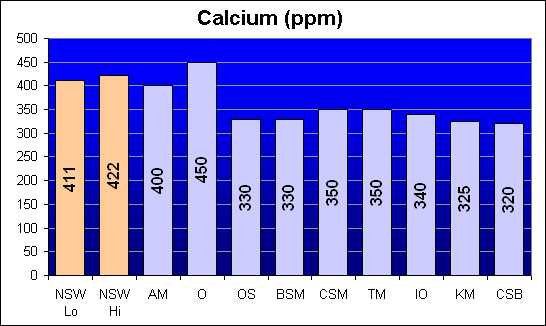
Iodine (ppm)
Another halogen like Bromine, Iodine is generally not considered a heavy metal contaminant. All salts except Omega Sea tested below the 0.5 ppm test detection limit.
Potassium (ppm)
Potassium is a major element in sea water that generally exists as a free metal ion. All salt mix levels were slightly below NSW concentrations.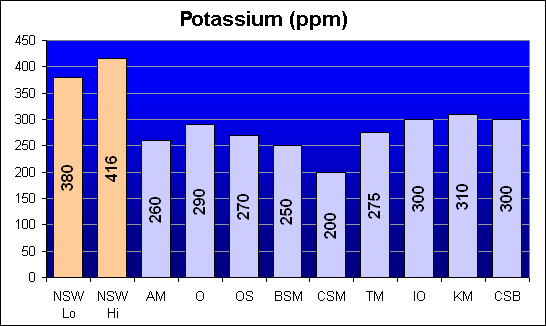
Magnesium (ppm)
An essential part of the buffer system, Magnesium levels were generally similar to NSW for all salt mixes.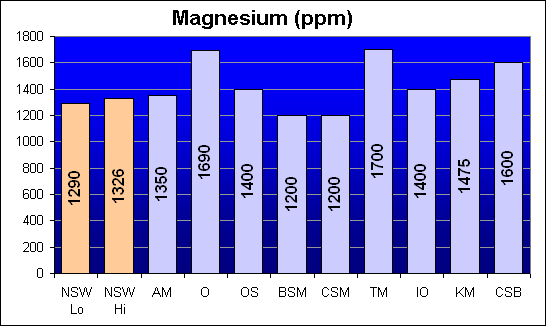
Sodium (ppm)
Sodium is the second most common element in sea water, after Chlorine. All salt mixes were slightly below NSW levels.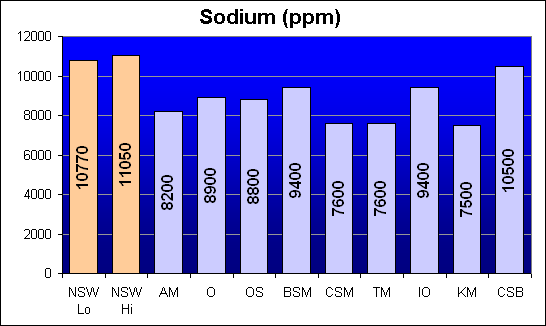
Rubidium (ppb)
Rubidium is potentially a heavy metal toxin, but all salt mixes were well below NSW levels.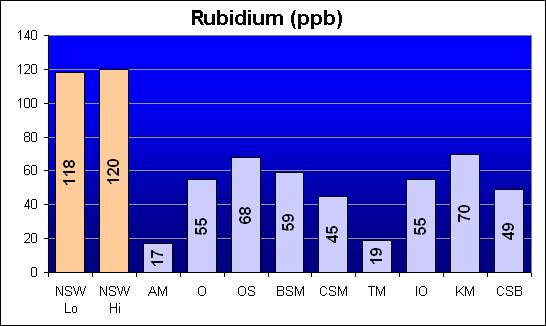
Sulfur (ppm)
Sulfur exists in sea water primarily as Sulfate ions. All salt mixes had similar Sulfur levels, well below NSW levels.
Vanadium (ppb)
Vanadium is another heavy metal that was reported in Dr. Shimek’s study to be significantly higher in Instant Ocean and Coralife than in Crystal Sea Bio-Assay. Our results indicate that Crystal Sea Bio-Assay is comparable to Instant Ocean, and that Bio-Sea MarineMix measures the highest.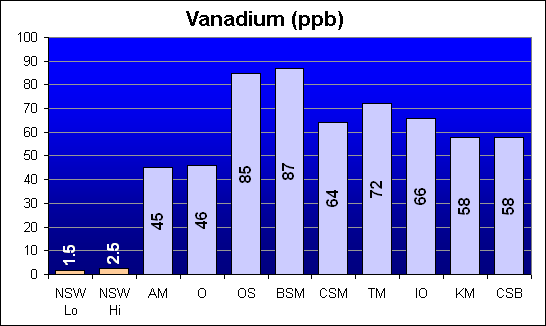
1 “This study has demonstrated that the artificial sea water made using some common and popular commercial artificial salt water mixes is toxic to sea urchin larvae using a variant of a standard bioassay. Such water will also likely have effects on other animals.” Shimek, 2003
2 “This study also showed that some artificial sea water mixes produced water that could support larval development as well as could natural seawater.” Shimek, 2003
3 “The two salts that made artificial seawater with the lowest survivorship of larvae consistently have heavy metals concentrations hundreds to hundreds of thousands times those found in natural seawater. Those salts that had the best survival had heavy metals concentrations that generally ranged about from, at worst, about one third to, at best, one thousandth those values.” Shimek, 2003
4 “… I had to rely on data provided by the manufacturer of Crystal Sea Marinemix Bioassay Formula. For the Bio-Sea Marinemix, I used the data from one of the advertising brochures describing the salt.” Shimek, 2003
5 “Fortunately, there is no a priori reason to doubt the veracity of either of these sources.” Shimek, 2003



0 Comments